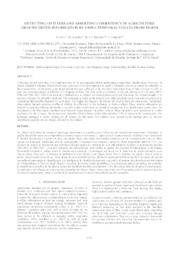Detecting outliers and asserting consistency in agriculture ground truth information by using temporal VI data from modis.
Detecting outliers and asserting consistency in agriculture ground truth information by using temporal VI data from modis.
Autoria: ARVOR, D.; JONATHAN, M.; MEIRELLES, M. S. P.; DUBREUIL, V.
Resumo: Collecting ground truth data is an important step to be accomplished before performing a supervised classification. However, its quality depends on human, financial and time ressources. It is then important to apply a validation process to assess the reliability of the acquired data. In this study, agricultural infomation was collected in the Brazilian Amazonian State of Mato Grosso in order to map crop expansion based on MODIS EVI temporal profiles. The field work was carried out through interviews for the years 2005-2006 and 2006-2007. This work presents a methodology to validate the training data quality and determine the optimal sample to be used according to the classifier employed. The technique is based on the detection of outlier pixels for each class and is carried out by computing Mahalanobis distances for each pixel. The higher the distance, the further the pixel is from the class centre. Preliminary observations through variation coefficent validate the efficiency of the technique to detect outliers. Then, various subsamples are defined by applying different thresholds to exclude outlier pixels from the classification process. The classification results prove the robustness of the Maximum Likelihood and Spectral Angle Mapper classifiers. Indeed, those classifiers were insensitive to outlier exclusion. On the contrary, the decision tree classifier showed better results when deleting 7.5% of pixels in the training data. The technique managed to detect outliers for all classes. In this study, few outliers were present in the training data, so that the classification quality was not deeply affected by the outliers.
Ano de publicação: 2008
Tipo de publicação: Artigo em anais e proceedings
Unidade: Embrapa Solos
Observações
1 - Por padrão são exibidas publicações dos últimos 20 anos. Para encontrar publicações mais antigas, configure o filtro ano de publicação, colocando o ano a partir do qual você deseja encontrar publicações. O filtro está na coluna da esquerda na busca acima.
2 - Para ler algumas publicações da Embrapa (apenas as que estão em formato ePub), é necessário ter, no celular ou computador, um desses softwares gratuitos. Sistemas Android: Google Play Livros; IOS: iBooks; Windows e Linux: software Calibre.
Acesse outras publicações
Acesse a Base de Dados da Pesquisa Agropecuária (BDPA) para consultar o acervo completo das bibliotecas da Embrapa.

